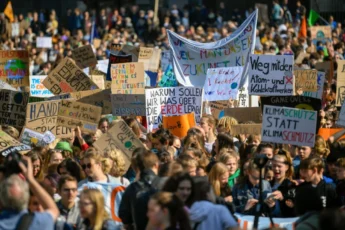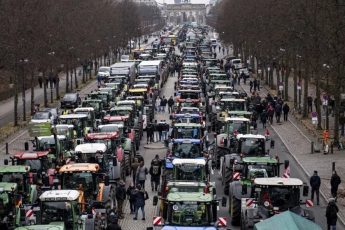
by Ovid Pop and Valentin Cernat (Alternator, Romania)
We publish this article by Valentin and Ovid, of the romanian collective Alternator. With this contribution, soon to be part of the second Issue of our Climate Class Conflict Journal, the authors shed light on current processes of privatization and dispossession fostered in Romania under the banner of the green transition. They also provide a clear picture of the way Western politics of war is embedded with the enhancement of green policies and the neoliberal reformation of market processes.
It’s now more than a year since the imposition of sanctions on Russia due to the escalation of the conflict in Ukraine. As we remember, it started with the festive intention on behalf of the US administration to ‘turn the ruble into rubble’. The EU population is now arguably more vulnerable to market fluctuations than ever before, being afflicted by a historical 9.2% inflation rate in 2022 (more than triple the annual value in 2021): rising energy prices, food insecurity and an overall decreasing standard of living. We are witnessing a curious and unique phenomenon in the one century long history of economic sanctions, when the countries that impose the embargo are suffering a severe back clash effect. This is, at least, true about Europe. Against this background, the European market is flooded with money that the EU-member states receive in form of grants and loans aimed at (we quote from the EU-commission web-platform): “restoring our nature”, ensuring “clean energy and transportation”, advancing new technology, digitalization, among other things. It’s called the Recovery and Resilience Plan. 723,8 billion Euros are to be pumped into the aging body of Europe’s technologies by 2026 in order to ensure this “green transition”. In other words, business is flourishing while the people slowly boil in anguish.
The US sanctions (backed by the EU) had as a consequence the narrowing of the supply in raw materials and other products coming from Russia. Gas and oil shortages are the well known examples here and of crucial significance, but the ban also influenced the imports of fertilizers, cereals, minerals, iron and so on. The sanctions generated a shock wave in the supply chain, creating new intermediaries along the supply lines, new gas and oil suppliers, a new infrastructure for transportation and storage, tightening Europe’s economic dependency on US-American business. Upon the sabotage of the Nord Stream 2 (in all likelihood conducted by or condoned by the US[1]), the logistical worlds of the two economies are becoming more intertwined. In fact, all this continues and deepens a trend which had already started during the Covid pandemic with disruptions in the supply chains. The reshuffling of the energy sector in Europe, a consequence of the war and of sanctions, goes hand in hand with the plan to renew the technology and get rid of the fossil fuel driven industry.
So, a question arises: would the sanctions have been implemented without the disbursement of the European Recovery and Resilience Funds (ERRF), the plan that was launched just a few months before the war escalated? Or from a different angle: were the investment funds in the green transition feasible for big business without limiting the supply offer in one way or another? Judging by the enthusiastic statements given by the private investors who salute both the ERRF and the sanctions with an almost religious fervor, we would conclude that no, they wouldn’t be feasible. Something is at stake. Corporate business is enthusiastic because it finds in war a good opportunity to elevate its industrial base to a new stage, which presumes to be friendlier on the environment, but the real stake – and this is crucial – is to be more competitive on the global market. EU corporate business needs to maintain that technological edge, insofar as it still has it in the competition with the US and China, while maintaining its grip on the political process. The ERRF provides exactly this: a legal and financial framework which ensures that power remains concentrated in the hands of the troika and big business. For green independence means nothing else than this: that the technological innovation, that big business needs, is paid with public money. This new deal does not change the matrix of the neoliberal state: public money for private corporate exploitation. And this regardless of the internal skirmishes European capitalists are caught into regularly, when their specific interests collide; their political arrangement needs to stay in place, keeping the status quo.
… Meanwhile the currency loses purchasing power due to inflation, which means that more labor is squeezed out of the working people across Europe, for the same amount of products they consume. No wonder that popular anguish and anger boil over. Protests, strikes and sit-ins erupted in most western countries from the UK to Spain, from France, to Germany and Czech Republic just to mention the most prominent. Following a tragic railway incident, weekly protests are organized in different parts of Greece accusing the state of criminal privatizations.
41% of the European Recovery and Resilience Plan (ERRP) for Romania is allocated to secure the green transition. Most of the money is spent on railway modernization, €3.9 billion. Smaller amounts are delivered to urban mobility (electric vehicles infrastructure), €1.8 billion, and energy efficiency of the buildings (construction sector), €2.7 billion. However, the smallest amounts are allocated to repair the wounds caused by the comprador capitalism of the last 32 years: clean energy production €0.8 billion and biodiversity and environmental protection €1.1 billion.
If one is still convinced of the good intentions of Europe’s business class, let’s take a look at the railway infrastructure in Romania. In 1989, the last year before the collapse of the socialist regimes, roughly 82% of the country’s product was transported by train – 69.000 million tones km. Today the percentage is nearly 20%, still much higher than the timid 8% of the EU average quantity. The neighboring socialist countries – Poland, Hungary, Bulgaria – show, in relation, similar performance and trends. However, railway transportation is the greenest transportation as it has very low impact on the environment, and the EU commissioners knows it very well. In fact, recently the EU committed itself to raise the percentage of railway freight transportation to 35% by 2035 and to decrease the road transportation by half by 2050. All very well. But first, corporate business needed to destroy the socialist logistics and in the first two decades, between 1990 and 2010, its main concern was only how to dismantle the railway infrastructure on claims that it was inefficient, technologically outdated etc. etc. In a rage of primary accumulation everything that was out there for privatization – train cars, warehouses, maintenance facilities etc. was privatized, sold out, devalued, concentrated in a handful of private owners. As a collateral result, the workers were laid off and the strongest trade union in the country, the railway trade union, well organized and numbering tens of thousands of members, if not more, was fragmented into smaller units and then dismissed. Parallel to this, the road infrastructure was extended and adjusted to the intermodal mode of transportation that links the container ships and liners to the trucks on the highways. Within a bit more than 10 years, the so-called logistics revolution (inaugurated in the US in the 1960’s) turned the infrastructure in Romania upside down. By 2010, almost 70% of the product was transported by road. So first, before even starting discussing the perspective of transiting toward green, corporate business needed to ensure that the modes of capital circulation corresponded to their interests – profit maximization. And that the ownership was snatched out of the hands of the State. Also, the political danger that the big infrastructure is charged with, as was the case with the socialist railway infrastructure, needed to be diffused, despite its environmental edge. In other words, there is always something for the present buried under the ‘communist’ rubble in Eastern Europe.
Coming back to the European Recovery and Resilience Plan: let us turn our attention to the expenses allocated and used in the transport infrastructure. Here we see that important sums of the total amount allocated for the green transition go for the construction of highways and road junctions, the modernization of railways, as well as investments in logistics centers and infrastructure in and around the Port of Costanța on the Black Sea. The purposes and uses of these investments are multiple. First of all, we note that the funds allocated from the ERRP in Romania for the green transition carry on and further develop an older plan through which transport infrastructures are built, rehabilitated and expanded now linking the Black Sea coast in Eastern Romania with the Western European logistics net, the so-called TEN-T, Trans-European Transport Network. The same is happening with the modernization of the railway system. Once absorbed into the neoliberal orbit, the railway is at last ripe for investments. Now that the investors are certain of their lion’s share, the network is ready for entering its green transition phase cladded in this brand new bride dress. When would it be wiser to use these European funds if not now when they serve both the militarization (i.e. the interests of the US military industrial complex) and the Western corporate elites!?
All these investments contain “environmentally friendly” elements that can be seen for what they really are: renewal of technologically outdated systems, renewal of car fleets with German electric vehicles, LED lighting and photovoltaic panels in logistics centers, charging stations for electric cars, low-consumption automation in freight transport, technology compliant with the latest European standards, etc. In their physical concreteness we can see the future of capitalism materializing. But the same ‘technological advancement’ obscures the political-economic purpose of the green transition, which remains thus hidden to the naked eye. That States are put in the service of capital, that the economy is gradually militarized, that trade monopolies are consolidated through this process of re-technologization, all this is hidden behind a foggy screen of environmentally friendly measures. The effects of this transformation are felt by the European peoples in the ever growing costs of living, which merely shows us how class warfare is waged today through financial and market mechanisms. Green transformation… What we need is a green revolution. A radical change of the political principle, after which the technology will follow suit. Revolution is the sustainable principle for the planet, not the transition. As a matter of fact, the peoples of Eastern Europe have a vivid memory of the word transition, which in every ear evokes the most savage plunder of the collective wealth and the impoverishment of the people. For the first 2 decades after 1989 transition was the word that stifled our public life leaving behind a wasteland on which the current class system arose. Now when the real wages in Europe are shrinking and the collective ownership over the technological development is under attack there is again talk of transition. This should sound the alarm.
Link to download more stickers
[1] While the European official investigations conclude only that it was a sabotage, the account given by the journalist Seymor Hersh is at least until now the most detailed analysis of the events leading to the destruction of Nord Stream 2: https://seymourhersh.substack.com/p/how-america-took-out-the-nord-stream [notes of the authors].





